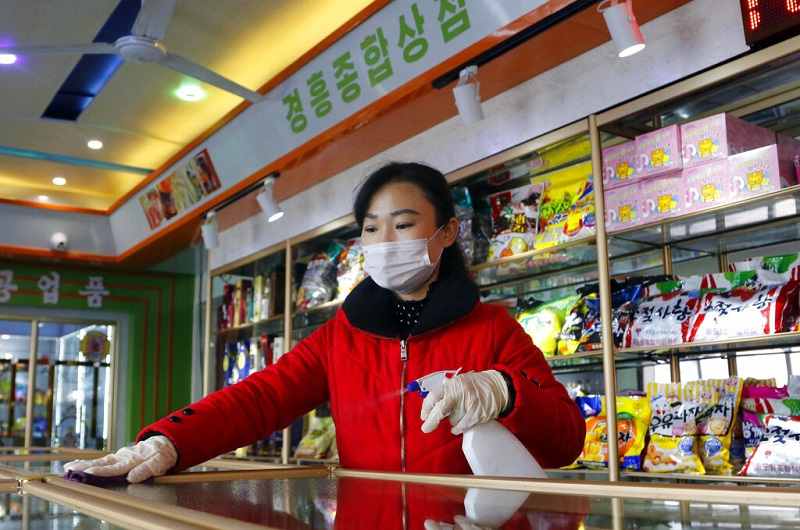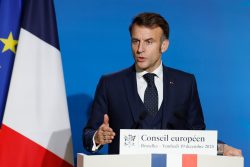
An employee of the Kyonghung Foodstuff General Store disinfects the showroom countertops in Pyongyang, North Korea, Wednesday, Nov. 10, 2021.
10:27 JST, May 14, 2022
SEOUL, South Korea (AP) — North Korea on Saturday reported 21 new deaths and 174,440 more people with fever symptoms as the country scrambles to slow the spread of COVID-19 across its unvaccinated population.
The new deaths and cases, which were from Friday, increased total numbers to 27 deaths and 524,440 illnesses amid a rapid spread of fever since late April. North Korea said 243,630 people had recovered and 280,810 remained in quarantine. State media didn’t specify how many of the fever cases and deaths were confirmed as COVID-19 infections.
The country imposed nationwide lockdowns on Thursday after confirming its first COVID-19 cases since the start of the pandemic. It had previously held for more than two years to a widely doubted claim of a perfect record keeping out the virus that has spread to nearly every place in the world.
North Korean leader Kim Jong Un during a meeting on anti-virus strategies on Saturday described the outbreak as a historically “huge disruption” and called for unity between the government and people to stabilize the outbreak as quickly as possible.
Kim expressed optimism that the country could bring the outbreak under control, saying most transmissions are occurring within communities that are isolated from one another and not spreading from region to region. The country since Thursday has imposed stronger preventive measures aimed at restricting the movement of people and supplies between cities and counties, but state media’s descriptions of the steps indicate people aren’t being confined to their homes.
Experts say a failure to control the spread of COVID-19 could have devastating consequences in North Korea, considering the country’s poor health care system and that its 26 million people are largely unvaccinated.
Tests of virus samples collected Sunday from an unspecified number of people with fevers in the country’s capital, Pyongyang, confirmed they were infected with the omicron variant, state media said. The country has so far officially confirmed one death as linked to an omicron infection.
Lacking vaccines, antiviral pills, intensive care units and other major health tools to fight the virus, North Korea’s pandemic response will be mostly about isolating people with symptoms at designated shelters, experts say.
North Korea doesn’t have technological and other resources to impose extreme lockdowns like China, which has shut down entire cities and confined residents to their homes, nor it could afford to do so at the risk of unleashing further shock on a fragile economy, said Hong Min, an analyst at Seoul’s Korea Institute for National Unification.
Even as he called for stronger preventive measures to slow the spread of COVID-19, Kim has also stressed that the country’s economic goals should be met, which likely means huge groups will continue to gather at agricultural, industrial and construction sites.
It’s unusual for isolated North Korea to admit to an outbreak of any infectious disease, let alone one as menacing as COVID-19, as it’s intensely proud and sensitive to outside perception about its self-described “socialist utopia.” But experts are mixed on whether the North’s announcement of the outbreak communicates a willingness to receive outside help.
The country had shunned millions of doses offered by the U.N.-backed COVAX distribution program, possibly because of concerns over international monitoring requirements attached to those shots.
North Korea has a higher tolerance for civilian suffering than most other nations and some experts say the country could be willing to accept a certain level of fatalities to gain immunity through infection, rather than receiving vaccines and other outside help.
South Korea’s new conservative government led by President Yoon Suk Yeol, who took office on Tuesday, has offered to send vaccines and other medical supplies to North Korea on humanitarian grounds, but Seoul officials say the North has so far made no request for help.
The viral spread could have been accelerated after an estimated tens of thousands of civilians and troops gathered for a massive military parade in Pyongyang on April 25, where Kim took center stage and showcased the most powerful missiles of his military nuclear program.
After maintaining one of the world’s strictest border closures for two years to shield its poor health care system, North Korea had reopened railroad freight traffic with China in February apparently to ease the strain on its economy. But China confirmed the closure of the route last month as it battled COVID-19 outbreaks in the border areas.
"News Services" POPULAR ARTICLE
-

American Playwright Jeremy O. Harris Arrested in Japan on Alleged Drug Smuggling
-

Japan’s Nikkei Stock Average as JGB Yields, Yen Rise on Rate-Hike Bets
-

Japan’s Nikkei Stock Average Licks Wounds after Selloff Sparked by BOJ Hike Bets (UPDATE 1)
-

Japan’s Nikkei Stock Average Buoyed by Stable Yen; SoftBank’s Slide Caps Gains (UPDATE 1)
-

Japanese Bond Yields Zoom, Stocks Slide as Rate Hike Looms
JN ACCESS RANKING
-

Keidanren Chairman Yoshinobu Tsutsui Visits Kashiwazaki-Kariwa Nuclear Power Plant; Inspects New Emergency Safety System
-

Tokyo Economic Security Forum to Hold Inaugural Meeting Amid Tense Global Environment
-

Imports of Rare Earths from China Facing Delays, May Be Caused by Deterioration of Japan-China Relations
-

University of Tokyo Professor Discusses Japanese Economic Security in Interview Ahead of Forum
-

Japan Pulls out of Vietnam Nuclear Project, Complicating Hanoi’s Power Plans
























